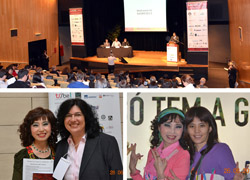
為貫徹祐生國際化的腳步、持續關注全球永續建築領域之相關發展,繼組團參與1998、2000、2002、2005、2008及2011年度之永續建築(SB)系列國際性會議,2012年5月10日除由本會林俊興董事長透過社團法人台灣永續建築環境促進會專款捐助iiSBE總會現任副理事長Dr. Vanessa Gomes所主辦之SASBE2012會議USD15,000外,2012年6月25日至2012年7月2日更由身兼社團法人台灣永續建築環境促進會理事長的黃晉英秘書長率領陳秋玉小姐,前往巴西聖保羅參加SASBE2012國際會議並發表台灣地區有關『永續之前、明天之後』論述之海報展覽,正式向國際社會宣告本會對氣候異變之主張與看法。
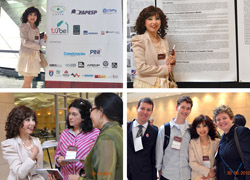
In order to realize the internationalization of Archilife Research Foundation and the concerns about the global development of sustainable building, after sending delegations to the SB international conferences held in 1998, 2000, 2002, 2005, 2008, and 2011, President Lin Chun-shin donated USD15,000 on May 10, 2012 through the TSSBE( Taiwan Society of Sustainable Built Environment) to support the SASBE2012 organized by Dr. Vanessa Gomes, current vice president of iiSBE. Likewise, Secretary General Huang Chin-ying, who is also the president of TSSBE, and Ms Chen Chiu-yu travelled to São Paulo, Brazil, to participate in the SASBE2012 from June 25 to July 2, 2012. At the SASBE2012, Archilife presented the theory on"Before Forever; After Tomorrow" at the poster session to announce to the international society Archilife's appeal and views on climate change.
2012年6月25日19:20黃秘書長等搭乘長榮航空BR2班機前往美國洛杉磯後轉搭大韓航空KE61班機,於當地時間2012年6月26日10:45抵達巴西聖保羅國際機場,隨即把握開會前之空檔,展開聖保羅市區之人文考察。
On June 25, 2012, Secretary General Huang Chin-ying and Ms Chen took Flight BR2 of EVA Air to Los Angeles, USA and transferred to Flight KE61 of Korean Air for São Paulo, Brazil. On June 26, 2102, Secretary General Huang and Ms Chen arrived at the São Paulo International Airport and immediately started with the cultural exploration of São Paulo during the free time before the conference.
第一站來到著名的「自由區」(Liberade),此區為世界上最大的海外日本社區,最引人注目的就是街道上到處可見鳥居路燈裝飾。因為聖保羅是一個各國移民雜居的城市,故本區內聚居著來自日本、韓國及中國等亞裔居民,也使本區成為東方色彩濃厚的重要商業區。
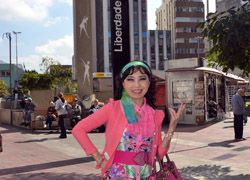
The first stop was the famous Liberade. It is the largest overseas Japanese community in the world. The torii streetlamp decoration is the most attractive scene. As São Paulo is a city of immigrants, there are immigrants from Japan, Korea and China, and the whole district has become an important business area with a strong oriental taste.
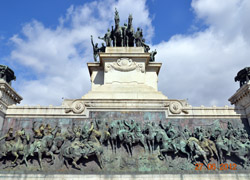
在享用完道地的巴西午餐後,黃秘書長等前往參觀位於聖保羅獨立公園內的獨立紀念碑。獨立紀念碑落成於1922年也就是巴西獨立滿100周年時,紀念碑正面碑底一幅大型青銅浮雕再現佩德羅一世當年宣布獨立時的情景,兩旁的兩座雕像為兩位向葡萄牙議會提交巴西申請獨立提案的議員,碑頂則為佩德羅一世向里約進軍的圖像。而紀念碑前的聖火也終年不熄,正與紀念碑前正面豎立的巴西國旗遙相呼應。
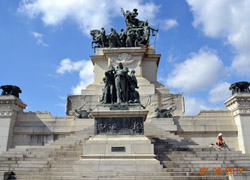
After the wonderful Brazilian lunch, Secretary General Huang Chin-ying and Ms Chen visited the Independence Monument in the Parque da Independência in São Paulo. The monument was completed at the centenary of Brazilian independence in 1922. A large bronze relief in front of the monument depicted the scene when Dom Pedro I declared independence from Portugal. Sitting on either side of the monument were the statues of two statesmen who submitted the proposition of independence to Portugal. At the top of the monument is a picture showing Dom Pedro I directing his army toward Rio de Janeiro. The fire in front of the monument will never be extinguished to correspond to the national flag of Brazil flying right in front of the monument.
接著前往巴西皇宮。巴西皇宮係模仿法國凡爾賽宮所建,庭園內噴泉流水與花壇草坪等造景,點綴金碧輝煌的皇宮,景色美不勝收,漫步其中,恍若穿越時空,置身18世紀的法國凡爾賽宮。
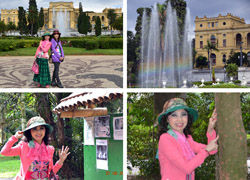
The Paço Imperial was the next stop. It was built according to the Château de Versailles. The fountains, streams, parterres and lawns on the yard decorated the golden palace. Wandering in these gorgeous scenes, it was like traveling across time and space to the Château de Versailles in the eighteenth century.
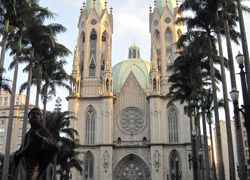
在下榻飯店稍作停留後,隨即前往聖保羅大教堂(São Paulo Cathedral)參觀。聖保羅大教堂位於天主教聖保羅總教區的主教座堂廣場內,是市區最大的教堂,建築風格融合了歌德式與文藝復興時期的特色。
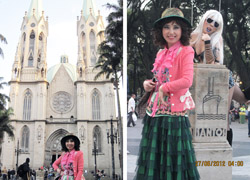
After a short stop at the hotel, Secretary General Huang Chin-ying and Ms Chen continued their cultural exploration to the São Paulo Cathedral. It is the cathedral of the Roman Catholic Archdiocese of São Paulo, Brazil. As the largest metropolitan church, the São Paulo Cathedral has an architectural style combining Gothic and Renaissance features.
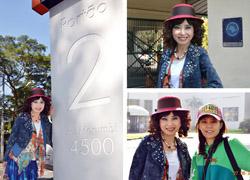
2012年6月27日,黃秘書長等前往聖保羅州政府大樓:旗士宮(Governments Palace)及足球場等地參觀。旗士宮於1970年正式闢為政府辦公的處所,建築宏偉,近似40年代的義大利建築風格。因為無法順利入內參觀,黃秘書長等於是繞行旗士宮,體驗熱帶風情的森林浴。接著前往聖保羅州立足球場朝聖,想像比賽現場熱力十足的氣氛。午餐則入境隨俗地享用巴西窯烤。
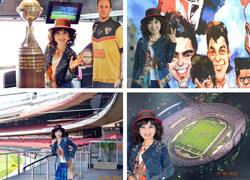
On June 27, 2012, Secretary General Huang Chin-ying and Ms Chen visited the site of the São Paulo State Government. It was officially transferred to the São Paulo State Government in 1970. In a style similar to Italian architecture of the 1940s, the building is magnificent. As it is not open for tourists, Secretary General Huang Chin-ying and Ms Chen walked around the site to experience the tropical forest ambiance. Next, they visited the Estádio Municipal Paulo Machado de Carvalho to imagine the power and excitement of football matches. Then, they enjoyed the churrasco at a local churrascaria for lunch.
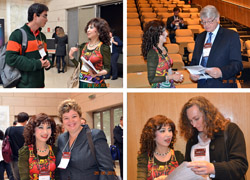
2012年6月28日及29日,黃秘書長等參與SASBE2012會議並張貼『永續之前、明天之後』海報。海報擇要內容如下:
On June 28 and 29, 2012, Secretary General Huang Chin-ying and Ms Chen attended the SASBE2012 and presented the posters on "Before Forever; After Tomorrow". The abstracts were as follows:
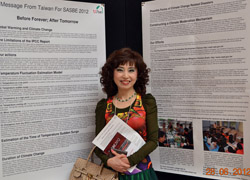 來自台灣的訊息 給 SASBE 2012永續之前 明天之後◎全球暖化與氣候變遷
來自台灣的訊息 給 SASBE 2012永續之前 明天之後◎全球暖化與氣候變遷全球暖化與氣候變遷是全世界關注的焦點,各國政府、民間組織對此複雜議題皆投入相關研究。其中,最具代表性的是IPCC報告,國際社會即依據IPCC報告,試圖掌握氣候變遷脈絡並提出因應策略。目前普遍被國際社會所認知的因應策略,概分為「減緩」與「調適」兩大面向。
◎IPCC報告的侷限性我們原本也參考IPCC報告,期望藉此掌握氣候變遷及其影響的全貌。可是,當我們用IPCC的推論比對近期世界各地陸續發生的超尺度複合型災難,發現IPCC報告幾乎沒有解釋與預測功能。考其原因,IPCC一開始就排除大自然的變化的部分,只鎖定 人為二氧化碳排放量的差異,導出不同情境假設的可能結果,這對「減緩」或許有些參考價值,但對於「調適」就顯得效用有限。
◎我們的行動有鑑於IPCC不當的假設前題,無法解釋已發生的現象,面對氣候變遷,此嚴重危及人類生存的重大議題,我們被迫用自己的方式,平行於IPCC,進行一系列的研究。我們在2004年開始探討氣候變遷的可能成因;在2005年提出氣溫升降推估模型,並探討氣候變遷對自然環境、人文社會的影響;在2007年起,研擬生態城市轉化步驟,探討氣候變遷下,人類新文明的可能發展方向;在2008年起,提出氣候變遷的時間表,並評估各國的氣候風險、預測各地的災難類型;在2010年比對已發生現象,自我校驗模型的可信度。
◎我們的努力基於台灣相對優勢的避災條件、讓地球恢復自我平衡的機能,以及以台灣做為新文明搖籃的願景,我們將努力的成果,在政府相關政策擬定時,適時提供建言,強化政府的應變機能!
(1)國家永續發展政策綱領:http://nsdn.epa.gov.tw/我們依研究成果,補入「生態系異常減災策略」與「疫病災害防救措施」。同時以共生循環概念,檢視綱領中,環境、社會、經濟各個面向的策略、目標,以及各部會提出的相關行動計畫,並檢視其是否符合永續發展指標的良性趨向。
(2)國家氣候變遷調適政策綱領(草案):http://www.cepd.gov.tw/ 我們依據研究推估的災變時間表,強調災變的緊迫性,提示在各調適領域的衝擊與挑戰,尤其應留意常態性災害釀成複合巨災的可能性;應將常態性災害孤立化,避免災害時間拉長。此外,亦應設法保留適度的能量,以因應未知災害的挑戰。
(3)生態城市轉化 在貼近民眾生活部分,我們正依據長期的研究成果,參照「國家永續發展政策綱領」及「國家氣候變遷調適政策綱領」,研擬「生態城市轉化」的七個步驟。我們將七個步驟,想像成七個階梯。每個城市所處的階梯位置或有不同,所需的轉化過程也就有差異。生態維持較佳的城市,或許只需三個步驟便可轉化成功;但是,大部分的都市環境已被破壞殆盡,可能就需要透過完整的七個轉化步驟才能達成目標。七個步驟依序為:
A.保水與保樹;B.生物多樣性;C.環境工程;D.環境監控;E.都市設計;F.綠建築;G.新文明:透過生活約束,以自給自足概念,數位化溝通傳輸及實踐自我價值方式,將整體改變化約成為文明教化,並實踐於生活之中。
這樣七個步驟才算全部完成,人們才可能展開永續的新文明!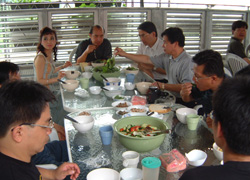
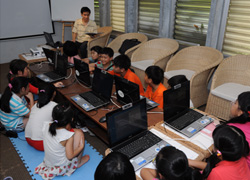 2002年8月31日在林俊興董事長、黃晉英理事長的帶領下,邀約成功大學江哲銘教授、台北醫學大學蘇慶華副校長、中台科技大學李宏謨校長等研究團隊,共同參訪共生圈一號(綠建築)並以共生餐(核酸食譜 )餐敘,體驗SB=GB+Symbiosis的共生化生活。2011年8月1日至5日於共生圈一號(綠建築)舉行暑假生活體驗營,在數位化方面由祐生研究基金會接續世代林容生先生開辦「數位軟體創意」課程,詳細說明如何運用簡易的程式指令,做出有趣的手機遊戲,教導學員體驗數位化的生活。Message From Taiwan For SASBE 2012Before Forever; After Tomorrow◎Global Warming and Climate Change
2002年8月31日在林俊興董事長、黃晉英理事長的帶領下,邀約成功大學江哲銘教授、台北醫學大學蘇慶華副校長、中台科技大學李宏謨校長等研究團隊,共同參訪共生圈一號(綠建築)並以共生餐(核酸食譜 )餐敘,體驗SB=GB+Symbiosis的共生化生活。2011年8月1日至5日於共生圈一號(綠建築)舉行暑假生活體驗營,在數位化方面由祐生研究基金會接續世代林容生先生開辦「數位軟體創意」課程,詳細說明如何運用簡易的程式指令,做出有趣的手機遊戲,教導學員體驗數位化的生活。Message From Taiwan For SASBE 2012Before Forever; After Tomorrow◎Global Warming and Climate ChangeGlobal warming and climate change have become the focus of world concern. Governments and NGOs have been deeply involved in the studies of this complex issue. Among them, the most representative study would be the IPCC report. Currently, the international community has used the IPCC report as the basis for their attempts to grasp the context of climate change and propose response strategies. Generally, the international community has recognized the coping strategies in two dimensions-"mitigation" and "adaptation".
◎The Limitations of the IPCC ReportWe have also taken reference of the IPCC report with an expectation to put the pieces together in terms of climate change and its impacts. However, when we compared the inferences proposed in the IPCC report to the ultra-scale composite-type disasters occurred around the world in the recent period, we found that the conclusions published in the the IPCC report have virtually no explaining or predictive power. The reason may have been that IPCC has ruled out the changes in the nature right from the beginning and only locked on to the differences in carbon dioxide emissions to search for the possible outcomes from different scenario assumptions. Such result may have some reference value for the "mitigation" theory but would be rather limited for the "adaptation" strategy.
◎Our actionsIn view of the IPCC's inadequate assumption that cannot explain the occurred phenomena, in the face of the serious issues of climate change that has been jeopardizing the lives of mankind, we are forced to use our own ways in parallel to the IPCC research for a series of studies. In 2004, we began to explore the possible causes of climate change. In 2005, we proposed the temperature fluctuation estimation model, and explored the impact of climate change on the natural environment and human society. In 2007, we began to develop the eco-city transformation procedures and discuss the direction of possible development of a new human civilization under the threat of climate change. In 2008, we put forward the timetable of climate change, assessed the climate risk for each country, and predicted the disaster types likely to occur in the different places. In 2010, the self-checking model was compared to the occurred phenomena for verification of the reliability. In the following section, we will present the results of our research arrived at this stage.
◎Our EffortsTaiwan has a comparative advantage for disaster avoidance and construction of a balance self-restoring mechanism for the Earth. We strive to build Taiwan into a cradle of a new civilization. Therefore, we will work to provide timely advises for policymaking and help the government to build a strong response mechanism.
(1)The Framework of National Sustainable Development Policies: http://nsdn.epa.gov.tw/We will supplement the previous research findings with the "Ecosystem Abnormality Disaster Mitigation Strategies" and "Epidemic Prevention and Remedy Measures". At the same time, we will review the strategies and goals in the different dimensions planned in the framework, including the environment, society, and economy, based on the symbiotic concept, propose relevant action plans to the relevant authorities, and verify whether the policies conform to the sustainable development indicators.
(2)The Framework of National Climate Change Mitigation Policies (Draft): http://www.cepd.gov.tw/Based on the forecast of the disaster occurring schedule with emphasis on the urgency, we will send out warnings for the possible impacts and challenges in each area of mitigation; we will pay attention to the possibility of composite catastrophes built up by the regularly occurring disasters. We should isolate incidents of regularly occurring disasters to prevent prolonged impacts. In addition, we should also make an attempt to reserve certain level of energy for the challenges of unknown disasters in the future.
(3)Eco-City TransformationFor the part that is closer to the lives of the general public, we are currently developing the "Seven Steps to Eco-City Transformation" based on "The Framework of National Sustainable Development Policies" and "The Framework of National Climate Change Mitigation Policies". We picture the seven steps as seven steps of a stairway, and each city is placed on a different level of this stair to indicate their different needs in the process of transformation. Cities with more intact ecosystems may need only three steps to successfully transform into eco-cities. However, the ecosystems of most cities have been completely destroyed, so they may need up to seven steps to achieve the goal. The following is a brief description of the seven steps:
A. Preservation of water and trees;B. Biodiversity;C. Environmental engineering;D. Environmental surveillance;E. Urban design;F. Green building;G. New civilization: Through self-moderating and self-sufficient living, digitalized communication, and self-fulfillment values, collective change can be developed into norms generally practiced in a society.
The seven steps form a full process and completion of the seven steps will bring the mankind into the age of a new civilization.  On August 31st 2002, President Lin Chun-shin and Judy, Huang Chin-ying led the Archilife team to host a tour of Symbiosphere 1 Center (green building). Professor Chiang Che-ming from Cheng Kung University, Deputy Principal of Taipei Medical University Su Ching-hua, and Principal of Central Taiwan University of Science and Technology Li Hong-mo are invited to experience a symbiotic banquet (nucleic acid meals) and the SB=GB+Symbiosis living.
On August 31st 2002, President Lin Chun-shin and Judy, Huang Chin-ying led the Archilife team to host a tour of Symbiosphere 1 Center (green building). Professor Chiang Che-ming from Cheng Kung University, Deputy Principal of Taipei Medical University Su Ching-hua, and Principal of Central Taiwan University of Science and Technology Li Hong-mo are invited to experience a symbiotic banquet (nucleic acid meals) and the SB=GB+Symbiosis living. From August 1st to 5th 2011, Archilife organized a summer camp at Symbiosphere 1 Center (green building). For digitalization, the Archilife Research Foundation continued the "Digital Software Creativity" program set up by the new generation member Mr. Lin Rong-sheng. This program illustrates how to use simple programming language to create fun game apps for phones and leads the participants to experience digitalized living.
From August 1st to 5th 2011, Archilife organized a summer camp at Symbiosphere 1 Center (green building). For digitalization, the Archilife Research Foundation continued the "Digital Software Creativity" program set up by the new generation member Mr. Lin Rong-sheng. This program illustrates how to use simple programming language to create fun game apps for phones and leads the participants to experience digitalized living. SASBE2012會議主要邀請各界針對智慧住居環境研發、回應氣候異變創新科技、評估系統、產官學界面改善、教育及智慧住居等主題進行個案分享與研討,並進行彙整。
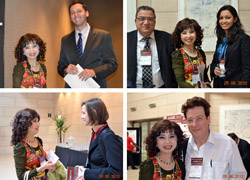
黃秘書長除利用會議舉辦的交流時間,與主辦人 iiSBE總會現任副理事長Dr. Vanessa Gomes及與會的各國貴賓交流切磋永續建築領域之近期發展,傳達來自台灣的重要訊息『永續之前、明天之後』論述,對於首次接觸祐生的年輕學子,黃秘書長也不厭其煩,耐心闡述祐生歷年的研究成果與共生圈一號之驗證實例,開啟他們前所未見的視野。現場並發送特意準備的『永續之前、明天之後』文宣,啟發與會人士有更完整的認識與理解。從現場所有的海報展覽內容中也可以發現,唯獨祐生所提出的看法能有效整合各專業領域,並確實落實生活面向的改革,讓研究不再是空中樓閣、高談闊論,而是能回歸生活層面,真正對症下藥,調適因為氣候變遷所帶來的各項衝擊。
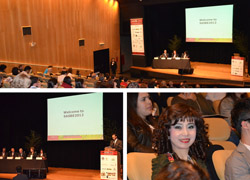
The SASBE2012 invited different sectors of society to share, discuss and conclude :1.Design, development and operation of smart and healthy workplace and living environments;2.New systems, innovative technologies and high performance products responding to emerging challenges such as climate change, closed materials loops, security, alternative energy, passive design, life-cycle assessment, and integration with natural systems;3.Evaluation on the methods and techniques of smart and sustainable design, construction, and operation of new built facilities and regeneration of existing ones;4.Improvement of sustainability deliverables in projects through management processes, regulations, governance and community engagement;5.Management of knowledge on innovation and sustainability for the built environment; and6.Communication, education and training of sustainable development principles and professional skills.7.Smart and sustainable buildings, infrastructure, districts, cities and the community.. At the exchange session of the conference, Secretary General Huang Chin-ying exchanged ideas about the recent SB developments with iiSBE VP Dr. Vanessa Gomes and guests from different countries, and relayed the important message from Taiwan: the theory of "Before Forever; After Tomorrow." To the young students who came in contact with Archilife for the first time, Secretary General Huang Chin-ying patiently explained to them the research outcomes of Archilife over the years and the empirical results from the Symbiosphere 1 Center, to open their eyes to this vision. At the venue, Secretary General Huang Chin-ying also distributed the publicity materials of "Before Forever; After Tomorrow" to participants to provide them with a better understanding and knowledge about the "Before Forever; After Tomorrow" concept. As shown in contents of all the posters presented at the event, only Archilife can effectively combine all professional fields and enforce them in the reform of life. This way, theories become not mere imaginations and eloquent talks but become something that can be practiced in real life to solve our problems and help us adapt to the impacts from climate change.
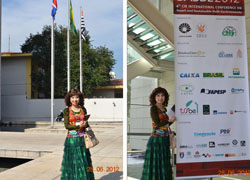
此外,黃秘書長也造訪拉美紀念館、共和廣場、聖保羅藝術博物館、先鋒旗手紀念碑、聖保羅中央公園及富人教堂等景點。拉美紀念館落成於1989年,為拉美最大的文化交流中心,彙集了圖書館、視聽館、禮堂、劇院、展覽中心、餐廳和辦公樓等不同的設施,由巴西的世界級大師奧斯卡‧尼邁耶(Oscar Niemeyer)所設計,以簡約的線條,營造出奇特的建築弧線,令現代主義散發出獨特的味道。
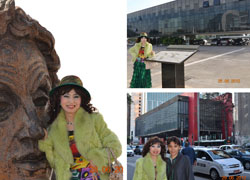
Secretary General Huang Chin-ying also visited a number of local attractions, including the Memorial da America Latina, Praça da República, Museu de Arte de São Paulo, Monumento às Bandeiras, Parque Ibirapuera and Wossa senhora do Brazil.
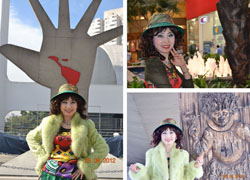
The Memorial da America Latina was completed in 1989. As the largest cultural exchange center in Latin America, the memorial is a complex integrating libraries, auditoriums, halls, theatres, exhibition centers, restaurants and offices. It was designed by the Brazilian world-class architect Oscar Niemeyer in a simplistic style featuring an arch to suggest the flavor of modernism.
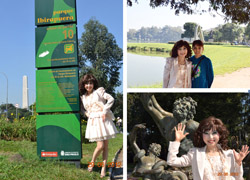
聖保羅藝術博物館位於聖保羅市著名的金融大道,為巴西最重要的藝術博物館,其內主要收藏了大量的畫作及二次世界大戰後雕刻家的作品。先鋒旗手紀念碑為聖保羅的代表性建築之一,為了紀念一群自稱先鋒旗手(Bandeirantes)的探險者開拓巴西彊界的卓越貢獻而建。聖保羅中央公園是聖保羅市之肺,平日是市民休憩、運動的好去處,同時也充滿人文藝術氣息,因園內的建築大多出自國寶級建築師奧斯卡‧尼邁耶(Oscar Niemeyer)之手,更吸引了不少建築迷前來朝聖。富人教堂則是巴西富人生活的真實寫照,在這裡辦一場婚禮起碼得預約等上3 年,且最低消費為25,000里拉起跳。
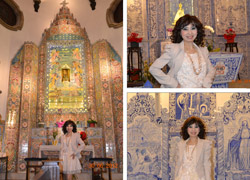
The Museu de Arte de São Paulo is located on the famous Avenida Paulista in São Paulo. As the most important art museum in Brazil, Museu de Arte de São Paulo has a large collection of paintings and works made by postwar sculptors. The Monumento às Bandeiras is one of the featured constructions in São Paulo.
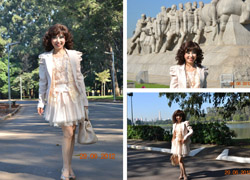
It was built to commemorate an explorer who called himself Bandeiras for his outstanding achievements in cultivating the Brazilian border. The Praça da República is the lung of São Paulo and the most frequently visited spot of locals for leisure and sports. It's a place for cultural experience. As most buildings in the park are designed by the national-treasure-grade architect Oscar Niemeyer, it also attracts many architectural lovers. The Wossa senhora do Brazil is an example of the life of Brazil rich people. It takes at least 3 years to book a wedding and the minimum charge is BRL25,000.
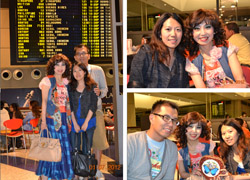
2012年6月30日12:45黃秘書長等搭乘大韓航空KE62班機經洛杉磯轉機,在等候轉機的空檔,海外特派員鄭伊寧小姐也專程前來洛杉磯國際機場會晤,黃秘書長除了分享巴西行第一手的實況報導,並耳提面命後續應持續追蹤與關注的議題與面向。在依依不捨道別後搭乘長榮航空BR1班機,順利於7月2日6:00返抵國門。
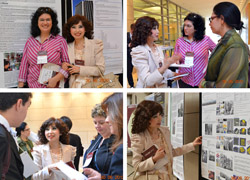
On June 30, 2012, Secretary General Huang Chin-ying and Ms Chen took Flight KE62 of Korea Air to Los Angeles on transit to Taiwan. During the transit, Archilife overseas correspondence Ms Cheng I-ning met them at the LAX Airport. Besides sharing with Cheng first-hand information of the SASBE2012, Secretary General Huang Chin-ying told her the issues to be followed up. After saying goodbye to Ms Cheng, Secretary General Huang Chin-ying and Ms Chen took Flight BR1 of EVA Air and smoothly returned to Taiwan on July 2.
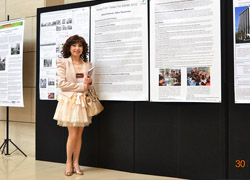
本次歷經來回57個鐘頭的飛行與轉機,一路從遠東地區橫越太平洋再跨越赤道、南回歸線,千里迢迢造訪位於南半球的巴西聖保羅,除了成功分享來自台灣對『永續之前、明天之後』的論述外,也實地考察巴西的風土民情,探索這個以足球、咖啡及森巴熱情著稱於世的民族外,對方才閉幕的Rio+20會議成果也有了近距離的觀察。往後將持續有系統地向國際發聲,讓祐生能為人類開啟新文明。
This trip travelling from the Far East across the Pacific Ocean, the Equator and the Tropic of Capricorn to São Paulo in the southern hemisphere took 57 hours of flying and transit. Apart from successfully sharing Taiwan's theory on "Before Forever; After Tomorrow" and exploring the culture and customs of this nation famous for football, coffee and samba, we were able to have a close look at the Rio+20 Conference. In the future, we will continuously and systematically tell the world of our beliefs so as to start a new civilization for humankind.